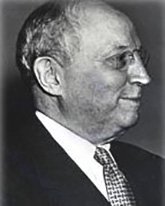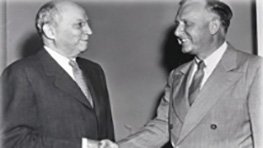1st World Bank President, June 18, 1946 - December 18, 1946
Personal History
Eugene Meyer was born in 1875 in Los Angeles. He attended Yale University, graduating in 1895. He worked at Lazard Freres banking house in New York, and in 1901 bought a seat on the New York Stock Exchange. By 1917 he had made a personal fortune by focusing on investments in the copper, gold, automobile and chemical industries. He developed a firm reputation on Wall Street as a solid manager of investment funds and as an innovator. His firm pioneered the use of a research department – scientific investing – to perform detailed economic analyses of businesses.
He had a great sense of public duty, and served at the Versailles Peace Conference, the Federal Farm Loan Board, and the Reconstruction Finance Corporation. In 1933 Meyer left the political world and purchased the Washington Post. He returned to public service during World War II to serve on the National Defense Mediation Board, and after the war planned to spend the rest of his career at the Washington Post. However, President Truman asked him to head the World Bank, and Meyer accepted.
Setting up the World Bank
Meyer seemed to be a good choice for Bank's first president. He had practical organizational experience and broad government experience. His Wall Street career earned him a reputation for innovative practices, careful dealing, and detailed economic analyses of investments.
Meyer's first task was recruitment of staff. He quickly appointed a vice president (Harold Smith), a general counsel (Chester McLain), and a director of the loan department (Charles Pineo). Many of the staff members initially chosen were to make long careers at the Bank – men such as Leonard Rist, Richard Demuth, Morton Mendels, Aron Broches, and Martin Rosen. By December 1946 the Bank's staff had grown to 150 people.
Meyer also tackled the problem of the Bank's organizational structure. One of his earliest initiatives was the establishment of a research department to provide senior officials with the data needed to make decisions about loans and guarantees, judgments about the conditions in the countries seeking assistance, and assessments of the availability of capital. Meyer appointed Leonard Rist as head of this important department, and within three months the research operation was under way.
Other organizational issues remained more tentative. The executive directors had set up a number of committees to deal with various aspects of Bank operations and policy, one of which dealt with the preferred organization of the Bank. The Organization Committee recommendations made the executive directors committees responsible for all administrative matters in the Bank. Meyer disagreed with these recommendations and resigned a few days later.
Meyer's most significant impact may have taken place outside the Bank itself. His reputation on Wall Street was one of the strongest assets he brought to the Bank, and investors welcomed his promise that the Bank would operate on sound investing principles. He actively promoted changes in state legislation in the U.S. which would allow insurance companies, savings banks and other bodies to purchase IBRD bonds.
Defining the Bank's Mission
The Bank's mission was another issue which needed clarifying when Meyer became president. The Articles of Agreement called for the Bank to make loans for reconstruction and for development. The European officials were particularly interested in post-war reconstruction. The U.S. executive director, Emilio G. Collado, wanted to make a development loan to Chile as the Bank's first operation. Meyer did not want to rush into operations, insisting upon a thoroughgoing analysis of any loan application before committing the institution to lending. (The Bank's first loan was made in May 1947, after Meyer's departure.)
Meyer also helped to define the relationship between the World Bank and the United Nations. Meyer and the executive directors feared that the Bank could become a political tool of the UN, and delayed making formal agreements between the two institutions. (A formal agreement was signed during McCloy's tenure.)
Conflicts Over Bank Governance
Consequently Meyer found himself involved in sharp clashes with the Bank's executive directors. Sources of major conflict were the division of responsibility between the president and the executive directors, and the role of the United States and the United Kingdom in the World Bank. These became the defining issues of Meyer's presidency. The executive directors saw their role to be initiators of policy, lending proposals, and funding initiatives; and responsible for all administrative matters in the Bank. The U.S. executive director - Emilio Collado, backed by the U.S. Treasury – was a strong proponent for power being in the hands of the executive directors. On the other hand, Meyer insisted that the Bank was to initiate policies and operations, and executive directors were to approve them. Collado and Meyer clashed on a number of issues, until Meyer suddenly resigned on December 4, 1946. Meyer's private comment was that he could stay on and fight – and probably win – "but I'm too old for that." It was left to Meyer's successor, John McCloy, to firmly delineate the line between "management" and the board of executive directors.
Although Meyer failed to resolve the question of the authority of the president in relation to that of the executive directors, he and his advisers began to confront issues that would be on the Bank’s agenda for years to come.

